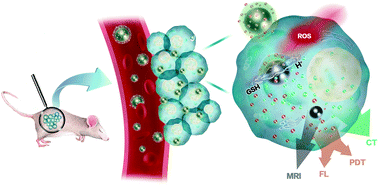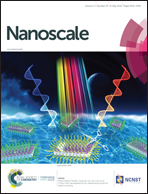pH/redox dual-stimuli-responsive cross-linked polyphosphazene nanoparticles for multimodal imaging-guided chemo-photodynamic therapy†
Abstract
Multifunctional nanodrugs with the integration of precise diagnostic and effective therapeutic functions have shown great promise in improving the efficacy of cancer therapy. We report herein a simple and effective approach to directly assemble an anticancer drug (curcumin), a photodynamic agent (Ce6) and tumor environment-sensitive molecules into cross-linked polyphosphazene and coat on superparamagnetic Fe3O4 nanoclusters to form discrete nanoparticles (termed as FHCPCe NPs). FHCPCe NPs have high physiological stability and good biocompatibility, and can enhance accumulation in tumor tissue via the enhanced permeability and retention effect. Meanwhile, the FHCPCe NPs exhibit an effective performance of dual-modality magnetic resonance imaging (MRI) due to the Fe3O4 cores and fluorescence imaging (FL) in the xenografted HeLa tumor because of the fluorescence of Ce6. Importantly, under the conditions of supernormal glutathione levels and acidic microenvironment in tumor tissue, curcumin and Ce6 can be effectively released by the degradation of FHCPCe NPs. Therefore, excellent anti-tumor effects both in vitro and in vivo have been achieved by synergistic chemotherapy/photodynamic therapy (CT/PDT) using multifunctional NPs. Our study highlights the promise of developing multifunctional nanomaterials for accurate multimodal imaging-guided highly sensitive therapy of cancer.



 Please wait while we load your content...
Please wait while we load your content...